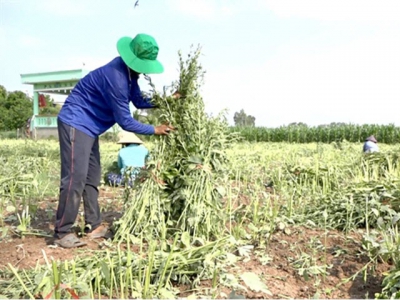Đồng Tháp rice farmers switch to other higher value crops

ĐỒNG THÁP — The Cửu Long (Mekong) Delta province of Đồng Tháp has switched to growing other crops this year on 3,570ha of unproductive rice fields, according to its Department of Agriculture and Rural Development.
Harvesting sesame in Đồng Tháp Province’s Hồng Ngự District. — VNA/VNS Photo Chương Đài
Farmers have either stopped growing rice on these lands or grow it only in the rainy season, preferring other short-term crops during other months.
The other crops include fruits, sesame, corn, sweet potato, red chilli, and lotus.
Huỳnh Tấn Đạt, deputy director of the department, said the switch has helped reduce water use, improve soil fertility and prevent the spread of rice diseases.
Under the province’s agriculture restructuring plan, the department encourages farmers to make the switch to eliminate the rice monoculture and improve farmers’ incomes.
Vegetables and other short-term crops yield two or three times the income from rice, while for fruits it is three to eight times, according to the department.
Nguyễn Văn Mười of Thanh Bình District’s Tân Mỹ Commune did not grow the winter-spring rice crop in 2019–20 in his one-hectare field and instead grew lotus.
After two and a half months, he harvested eight tonnes of lotus seed pods and earned nearly VNĐ100 million (US$4,300), or almost three times what he would have earned from rice, he said.
This summer-autumn, many farmers have switched to sesame in drought-prone areas since there is a lack of irrigation water due to salinity in rivers.
Lê Văn Chiến of Hồng Ngự District’s Thường Phước 1 Commune said he has been growing two rice crops and one sesame crop a year on his one-hectare field for the last five years.
Sesame grows better than rice in hot weather and without much water, he said.
This year, sesame farmers have had a bumper summer-autumn crop and good prices.
In Hồng Ngự District, sesame farmers got yields of more than a tonne per hectare and prices of VNĐ50,000 ($2.1) a kilogramme, up VNĐ10,000-15,000 from past years.
Sesame fetches farmers incomes of VNĐ30-35 million ($1,300-1,500) per hectare.
Đạt, deputy director of the department, said it is a drought-resistant crop, which the province has planted on more than 2,600ha, mostly in Lấp Vò, Cao Lãnh and Đồng Tháp districts.
Increasingly, local farmers are adopting advanced techniques to improve yields and quality besides linking up with companies to ensure they can sell their produce.
Additional income
Besides switching to growing lotus from rice, many farmers also welcome tourists who come to admire their lotus flowers to earn an additional income.
Đồng Tháp is renowned nationwide for its beautiful lotus growing areas.
To augment their services, farmers build bridges and offer boats and other facilities so that visitors can go around their lotus fields and take photos.
Nguyễn Văn Thuận of Tháp Mười District’s Trường Xuân Commune has turned his 10ha rice field into a lotus pond since last year and earns VNĐ50 million ($2,100) per hectare annually.
This year, he has been investing in setting up more tourism facilities, including food.
Mai Thị Hoa of Hồng Ngự District’s Tân Hội Commune receives around 100 visitors a day who come to her lotus field to rest and take photos.
She charges entrance fees of VNĐ10,000 for adults and VNĐ5,000 for children and could also sell 100 kilogrammes of fresh lotus seed pods at VNĐ20,000 each to the visitors, she said.
Previously, she used to sell to traders at a price of VNĐ8,000, she said.
Có thể bạn quan tâm
 Awakening domestic consumption of lychees
Awakening domestic consumption of lychees The consumption of lychees this year has continuously faced difficulties as the traditional export market of lychees still tightens control on imports
 Bac Giang plans to boost domestic lychee consumption
Bac Giang plans to boost domestic lychee consumption The northern province of Bac Giang will promote domestic consumption of lychees due to difficulties faced in exporting this kind of fruit this year.
 China has bountiful litchi crop, Vietnam worries about its litchi sales
China has bountiful litchi crop, Vietnam worries about its litchi sales Vietnam’s farmers have been warned of difficulties exporting litchis to China, which expects a bountiful crop this year.